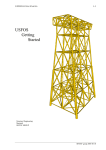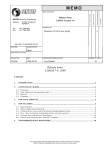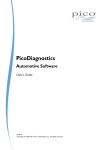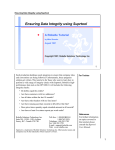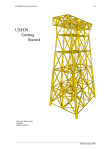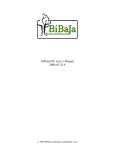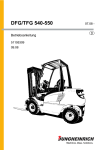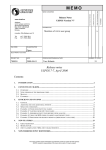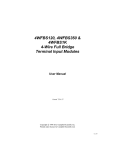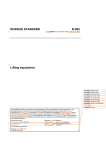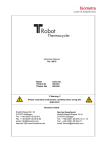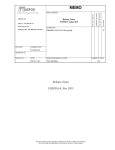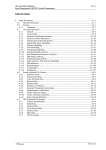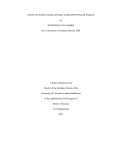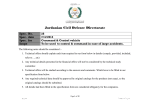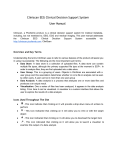Download Release note
Transcript
www.USFOS.com AS AGREED Phone: +47 905 05 717 COMMENTS ARE INVITED Release Notes USFOS Version 8-7 USFOS AS FOR YOUR ATTENTION MEMO CONCERNS FOR YOUR INFORMATION MEMO DISTRIBUTION Enterprise No.: NO 986 827 374 MVA FILE CODE Members of USFOS user group X CLASSIFICATION Confidential REFERENCE NO. PROJECT NO. DATE PERSON RESPONSIBLE / AUTHOR 2014-01-01 Tore Holmas Release Notes USFOS 8-7, Jan 2014 This memo contains project information and preliminary results as a basis for final report(s). USFOS AS accepts no responsibility of this memo and no part of it may be copied. NUMBER OF PAGES 19 2/19 1 INTRODUCTION ...................................................................................................................3 2 CHANGES IN VERSION 8-7 ................................................................................................4 2.1 3 RESTRICTIONS ON SHELL ELEMENT ANGLES .......................................................................4 NEWS IN USFOS VERSION 8-7 - 2014. ..............................................................................6 3.1 INTRODUCTION ...................................................................................................................6 3.2 HOW TO UPGRADE YOUR USFOS VERSION ...........................................................................6 3.3 ENHANCED GRAPHICAL USER INTERFACE ..........................................................................7 3.3.1 All-Time-High............................................................................................................7 3.3.2 Visualization of Local Axes .......................................................................................8 3.3.3 Visualization of Heavy Items .....................................................................................9 3.4 TUBULAR JOINT CAPACITY MODELS ................................................................................10 3.4.1 NORSOK Revision 3................................................................................................10 3.5 EARTHQUAKE ...................................................................................................................10 3.5.1 Delay .......................................................................................................................10 3.5.2 Stretching/Compressing ..........................................................................................11 3.6 SUPPRESSING BUCKLING OF INTEGRATED PLATE-I-GIRDER...............................................12 3.7 UNLOADING AFTER BOAT IMPACT ....................................................................................13 3.8 BUCKLING CURVES (CINIDEF) .......................................................................................13 3.9 LOAD PANELS FOR MAPPING TO FE-ELEMENTS ................................................................14 3.10 PUSHDOWN ANALYSIS (FIRE) ...........................................................................................14 3.11 LOCAL AXIS OF ZERO-LENGTH SPRING (ELMTRANS) .......................................................14 3.12 SWITCHES, (SPECIAL OPTIONS). ...................................................................................15 3.13 UPDATES USFOS AND UTILITY TOOLS ..............................................................................16 3.14 NEW/MODIFIED INPUT COMMANDS ...................................................................................16 3.15 DOCUMENTATION .............................................................................................................16 4 WARNINGS AND HINTS ...................................................................................................18 4.1 4.2 4.3 JOINT MODELLING AND PILE-IN-LEG. WARNING..............................................................18 USE OF NONSTRU AND LIN_ELEM. WARNING ..................................................................18 BEAM HINGES. HINT. .......................................................................................................19 Release Notes USFOS version 8-7 USFOS AS 2014-01-01 3/19 1 Introduction The current official version of USFOS is version 8-7 with release date 2014-01-01. The release contains the following: Release Notes (this MEMO) Updated software on Extended examples library on Updated manuals on www.usfos.com www.usfos.com www.usfos.com Except for this MEMO, no written information will be distributed in connection with this release. All information is stored on the WEB. Release Notes USFOS version 8-7 USFOS AS 2014-01-01 4/19 2 Changes in version 8-7 In order to improve the quality of the analysis results, important changes are made: 2.1 Restrictions on shell element angles Illegal angles: < 10° Figure 2-1 Illegal small angles for 4- and 3-node shell Extreme small element corner angles are checked for. If the angle is less than 10°, USFOS will report this as an illegal angle and stop with an error message. Following information are given: • • The elements are printed in the “out” file The USFOS label file: “prefix”_illegal_shell_angles.usl” could be opened in xact and the illegal elements are shown. The best option is always to modify the structural model and remove the bad-shaped elements. However, if the user decides to keep the elements, the “ILLEGAL” command could be used to bypass the check. Figure 2-2 describes the recommended “bypassing”: Specification one-by-one. This option means that the user has an overview over important and less important elements, (which f ex remain elastic or have “no” practical load carrying function). The option works as follows: • • A new minimum angle is defined by the user The element to accept are listed The minimum angle could be re-defined several times. The commands are executed in the specified sequence. Release Notes USFOS version 8-7 USFOS AS 2014-01-01 5/19 ‘ Key-1 Illegal ShellAngle Opt Accept ‘ Key-1 Illegal ShellAngle Opt Elem Value 9 ! Redefine Min angle IDs 1001 2001 3001 1002 ! Accept elem 1001 and 1002 2002 ! Accept elem 2001 and 2002 3002 ! Accept elem 3001 and 3002 Figure 2-2 Accepting elements with small angles. Specification element-by-element The “lazy” (not recommended) version is to accept all short elements without any specification. A warning will be printed in the output file, (see Figure 2-4). ‘ Key-1 Illegal ShellAngle ‘ Key-1 Illegal ShellAngle Opt Accept Value 5 ! Redefine Min angle Opt UsersRisk ON ! Accepting everything unchecked Figure 2-3 Accepting elements with small angles without element specification ------------------------------------------------* * * W A R N I N G * * * --Unconditionally Acceptance of --Very Small Angles on Users own Risk ------------------------------------------------- Figure 2-4 The warning is printed in the output file. In the output file (.out), the results from element checking are printed. If illegal elements are found, the analysis stops, and an USFOS Label file (name: illegal_shell_angles.usl) is created. By opening this file (File/Read Labels from file), a label with the angle is attached to each illegal shell in the graphical presentation of the model. Release Notes USFOS version 8-7 USFOS AS 2014-01-01 6/19 3 News in USFOS version 8-7 - 2014. 3.1 Introduction The new features are described by examples in this memo and in the updated manuals. In addition to the usual platforms, (win32, LINUX-and maxosx-64), version 8-7 is also built on win64. All utility software found under “modules” is built on 32bit platform and works therefore on both win32 and win64 computers. 3.2 How to upgrade your USFOS version From release 8-6, USFOS could be upgrades in different ways: Alt 1: Download the new “setup.exe” and u-install/install USFOS, (same as for release 8-6). This operation requires administrator rights on the PC. This alternative is required if the 64 bit windows is installed. Alt 2: Download module by module and copy into the application folder, (typical “C:\Program Files\USFOS\bin”. This operation requires write access on C:, but no administrator rights are required since no installation operations are performed, (just file copy). With alternative 1, all modules and the on-line manuals are updated. For alternative 2, (Win32 only), following should be done: Download USFOS module , unzip and copy into C:\Program Files\USFOS\bin Download xact, (complete package) , unzip and copy into C:\Program Files\USFOS\bin Download USFOS and xact user’s manuals. Copy into C:\Program Files\USFOS\bin Alternative 2 means that the existing files located on the Application folder will be over-written, (take a backup copy of the actual files if you want to keep your existing USFOS modules). Similar procedure is used for other USFOS modules, (for example STRUMAN). Release Notes USFOS version 8-7 USFOS AS 2014-01-01 7/19 3.3 Enhanced Graphical User Interface The graphical user interface (xact) has been enhanced since last year’s release. The GUI version released together with USFOS 8-7 is “2.7” for the Win-64bit version. The functionality is the same on win32 and win64, but the win64 version has access to more memory. 3.3.1 All-Time-High Element results are changing during an analysis. For example will the plastic utilization change during an earthquake simulation. This new option makes it possible to create one “all-time-high” presentation up to the actual load level. For example: If the last stored load step in the analysis is selected, the “all-time-high” for the entire analysis is displayed. Figure 3-1 Verify All Time High menu Figure 3-2 presents the usual “element plastic utilization” at point for full load (left) and for a later step (mid) after unloading of the force. The “all-time-high” (right) will remember the highest utilization of every member up to the actual load step. Full Load Unloaded All-Time-High “remembers” Figure 3-2 – “All-time-high” plastic utilization of cyclic loaded frame Release Notes USFOS version 8-7 USFOS AS 2014-01-01 8/19 3.3.2 Visualization of Local Axes The local Z-axis of beam elements is visualized using “Global Vector/Verify/Local Z-Axis”. The arrow-length is automatically set relative to the model size, and the length could be changed using the “Verify/Vector Settings” menu. Clipping and display parts on/of could be used to zoom into actual element(s). Figure 3-3 - Verification of Local Z-axis for Beam Elements Figure 3-4 – Adjusting Arrow-size (Verify/Vector Settings) Figure 3-5 - Use Clip and show parts on/off to easier see actual elements Release Notes USFOS version 8-7 USFOS AS 2014-01-01 9/19 3.3.3 Visualization of Heavy Items Heavy items are normally modelled using one or more NodeMass definitions. Node masses have been possible to visualize in xact for several years, (blue bars, and the lengths reflect the relative magnitude). However, in order to improve the information from an analysis, some new equipment mass definitions are introduced (see user’s manual). In the USFOS analysis, the masses from these 1- 2and 4-node mass-elements are applied as usual node-masses, but in xact, the items are visualized as shown below. Figure 3-6 - 1-node equipment. Two items are shown to the right. Figure 3-7 - 4-node equipment. The 25% of the total mass per node. Release Notes USFOS version 8-7 USFOS AS 2014-01-01 10/19 3.4 Tubular Joint Capacity Models 3.4.1 NORSOK Revision 3 A new capacity curve is added to the joint option: Norsok Revision-3. This option is activated with the following ChJoint command: Node ‘ ChJoint 101 Ch1 10 Ch2 20 Geo 0 Rule NOR_R3 Figure 3-8 Activating Norsok Revision-3 joint capacity 3.5 Earthquake 3.5.1 Delay Often, ground motion time histories starts for time=0.0. If loads should be applied prior to the earthquake, and this takes some time, the earthquake could be delayed using the new option: SWITCHES Earthquake Delay ∆T This means that all motion histories defined are delayed a certain time ∆T. ∆T Figure 3-9 - Original Motion History (left) and delayed a time ∆T (right) Release Notes USFOS version 8-7 USFOS AS 2014-01-01 11/19 3.5.2 Stretching/Compressing When a structure experiences an earthquake (ground motion), the response is highly dependent on the dynamics. If the ground moves with a period close to the fundamental eigen-periods of the structure, the response increases for every cycle. Ground motions used in design are often based on recorded earthquakes adapted to the actual field. In order to demonstrate the robustness of the structure, these design Time Histories could be “stretched” and “compressed” as shown in Figure 3-10. The stretching and compression means that the time axis is scaled with a factor >1 (stretching) or <1 (compressing). By for example running the simulation with ±30% (stretching factor 1.3 and 0.7), it could be demonstrated that possible resonance periods are checked. Figure 3-10 - Original Motion history (left), Stretched (mid) and Compressed (right) By specifying the command: SWITCHES Earthquake Stretch Factor All motion histories are stretched/compressed with the same factor. Release Notes USFOS version 8-7 USFOS AS 2014-01-01 12/19 3.6 Suppressing buckling of integrated plate-I-girder The USFOS beam-column element predicts the correct buckling with only one element per physical member. When needed, a mid-node is inserted (internally) and the element is split into two ½ elements. This is normally an advantage since the user does not need to worry about mesh density to obtain the correct ultimate capacity. However, in some cases this local member buckling is not wanted. For example: If an I-girder is continuously welded to a plate, the girder is suppressed from buckling about the weak axis. Only buckling about the strong axis is possible. By specifying: SWITCHES Solution PlateEdge ON USFOS will search for I-girders attached to plates and suppress buckling about the weak axis of the I-girder. Figure 3-11 demonstrates an axially loaded panel, where the two I-girders buckle in a nonphysical manner for a relatively low compression load. The image in the middle shows the behaviour with the weak-axis buckling is suppressed. The image to the right shows that the panel could buckle about the strong axis, (which the physical correct behaviour of this integrated structure). Weak axis buckling Suppressed buckling Buckling about strong axis only Figure 3-11 - Stiffened Plate. (shell + beam elements) Release Notes USFOS version 8-7 USFOS AS 2014-01-01 13/19 3.7 Unloading after boat impact When a boat impact is completed (reached the energy level specified in the BIMPACT record), the impact force is unloaded to zero. Originally, the default increment during unloading was 0.1, but in version 8-7, this factor is reduced to 0.02 (i.e. 50 steps if no step scaling takes place). In addition to this changed default, the user may control the load factor used during unload using the following command: SWITCHES Impact UnLoFact loadFactor For example: SWITCHES Impact UnLoFact 0.01 ! Unload 1% per step 3.8 Buckling Curves (CINIDEF) Some of the buckling curves are changed slightly to become consistent with respect to the use of factors (load/ and material). All buckling curves could be defined using the key-words given in the manual. The former “NPD” series are now renamed to EuroCode-3, (Euro3_A, Euro3_B, etc). Cinidef introduces imperfection also on I- and Box sections. The strong axis parameters are used in the buckling formulas. Release Notes USFOS version 8-7 USFOS AS 2014-01-01 14/19 3.9 Load Panels for mapping to FE-elements If for example an area load or explosion pressure should be mapped to a large number of shell elements, the new LOAFIELD option could be useful. Shell elements located closer to the panel than a certain user-defined tolerance will get the actual pressure. The load orientation will follow the direction of the load panel, (unaffected about the local sequence numbering of each shell element). 4 shell elements 1 load panel Shells and Panel 3.10 PushDown analysis (fire) If fire degradation analysis should be performed, the PushDown command is recommended. This command will modify every element’s section capacities based on the actual temperature field. This new option is an extension of the existing “FireChk” option, and is prepared for more detailed cross section temperature data from FAHTS. 3.11 Local Axis of Zero-length spring (ElmTrans) In addition to the more general definitions of the “main element” for definition of the local coordinate system of a zero-length-spring, a direct definition is available. The keyword “MainBeam” is used to specify the element. See User’s manual. Release Notes USFOS version 8-7 USFOS AS 2014-01-01 15/19 3.12 SWITCHES, (Special Options). The command “SWITCHES” was introduced in 8-5 to switch on special options and is extended in version 8-7. Following “Switches” commands are available, (subkeys in bold are new): KeyWord SubKey Value Description Min Max imperfection (in CINIDEF). General IndefLimit Defaults Version ver WaveData TimeInc val 0.05 1 % 850: switch to version 8-5 defaults 870 Time between each hydrodyn calc. Every ON ON 0 1 SeaDim Level val X , Y-dim Switches OFF oppler effects. Switches OFF storing of wave data for visualiz. Specify Tidal Level Change accuracy. 0: old accur, 1: new accur Specify size of sea surface used in xact NodeData DoublyDef ON/OFF ON: Accept doubly defined nodes with same coo OFF StatusPrint MaxElem val Iterations RLF_Calc - Write FE_Model Case/stp LinDepAlt - FracRepeat PlateEdge MxRep ON/OFF Impact InclDent Algorithm Visualization NoDoppler NoStore TidalLevel Accuracy Solution StrainCalc Results WindData EarthQuake - Default Max element in status print 2λ 10 Activate “Residual Load Factor” method OFF Writes deformed FE model at given case/stp OFF Writes ZL-springs for each BLINDP2 Off 10 OFF UnLoFact Max fracture repeates Avoiding I-girder to buckle about weak axis if the beam element is attached to a plate element Load factor during unloading after boat impact ON/OFF val ON/OFF OFF: not included. ON: included 0: old. 2: new, incremental. Including Gradients. ON/OFF ON 2 ON ShellComp ReynDep “val” ON/OFF Number of shell results Switch to Reynold-number dependent Cd 0.02 5 OFF Delay Val Delays earthquake with specified time 0 Stretch Val Stretches the motion history with specified value 1 Table 3-1 SWITCHES options Release Notes USFOS version 8-7 USFOS AS 2014-01-01 16/19 3.13 Updates Usfos and Utility Tools News, corrections and updates are described on the web, and it is recommended to check the following link: http://www.usfos.no/news/index.html 3.14 New/modified input commands Since last main release (8-6), following input identifiers are added/extended: PushDown LoaField Equip_1N Equip_2N Equip_4N : : : : : CHJOINT : SWITCHES : ELMTRANS : New command New command New command New command New command : Fire Degradation analysis : Load Field. : 1-Node Mass Object. : 2-Node Mass Object. : 4-Node Mass Object. Extended command Extended command Extended command : Norsok Revision 3 joint curves. : See above. 3.15 Documentation The following documentation, (updated or new), is available on the web: User’s manual PILERES users’s manual JNTRES user’s manual d2p user’s manual Release Notes USFOS version 8-7 : Updated document : New : New : New USFOS AS 2014-01-01 17/19 Tool d2p Description Comment Converts nodal displacements (nodeID + 6 displacement components) to prescribed, or forces displacement input to USFOS. (NODEDISP or NODELOAD+SPRNG2GR) JNTRES Joint Strength overview. Extended Version Needs version 8-7 or higher PILERES Total- and Pile reactions from static analysis Needs version 8-7 or higher Table 3-2 Misc Utility Tools Release Notes USFOS version 8-7 USFOS AS 2014-01-01 18/19 4 Warnings and Hints 4.1 Joint modelling and Pile-In-Leg. Warning. When a pile goes inside a leg, the pile is forced to slide inside the leg. This is modelled in USFOS using the BLINDP2 command, where the pile node becomes a “slave” and the nearest leg elements becomes the “master element”. However, sometimes the user defines 2-node springs between the pile and the leg instead. If the spring is attached to a leg node, which is used in connection with CHJOINT, problems will occur. The spring will become a “brace” and the load transfer through the joint will not work as intended. 4.2 Use of Nonstru and Lin_elem. Warning Often, models created for linear elastic analysis are used directly for non-linear ultimate strength analysis. The quality of linear models varies much. Some models consist of components with sufficient strength to carry the functional loads, but too often, the models are unable to carry the self-weight. The reasons could be several: Early stage model (concept level), use of dummy elements and simply that the strength issue is pushed to the post-processing (code check) stage. When such problems occur, it is tempting to “fix” the model using NONSTRU and LIN_ELEM commands. Use of these commands in that context is another words for saying: “My model is not suited for non linear analysis”. The NONSTRU command was introduced for member importance studies, where one or more elements were removed and the impact on the ultimate capacity was checked. Controlled use seldom causes problems, but defining whole areas non-structural, could cause concentrated load transfer into the remaining structure and then cause new problems. The best solution is always to strip the model for surplus elements, but sometimes a careful change of material properties (increase yield and reduced stiffness) could be a good solution. The LIN_ELEM command could be replaced by a re-definition of the material, for example scaling the yield with a certain factor. This gives a better control of the “non-physical” areas of the structure. Material properties are easily changed using the CHG_MAT command, where the actual elements also could be referred to using the Group option. Release Notes USFOS version 8-7 USFOS AS 2014-01-01 19/19 4.3 Beam Hinges. Hint. Beam hinges could cause numerical problems if a group of elements give zero stiffness. If is possible to replace one hinge with a zero length spring + one extra node. Struman has an option for automatic generation of springs, (the new Hing2Elm commands). Contact [email protected] for examples. Release Notes USFOS version 8-7 USFOS AS 2014-01-01






















